本文首先构造了一个隐层h, 然后建立各个用户的所有评分softmax向量同h的联系,以此建立条件概率, 然后最大log-likelihood, 求出链接权矩阵. 再反过来求missing的关于各级评分的概率, 选择最大概率的评分作为预测评分(这是文中提出的一种方法)







| 文献题目 | 去谷歌学术搜索 | ||||||||||
| Restricted Boltzmann Machines for Collaborative Filtering | |||||||||||
| 文献作者 | Ruslan Salakhutdinov, Andriy Mnih, Geoffrey Hinton | ||||||||||
| 文献发表年限 | 2007 | ||||||||||
| 文献关键字 | |||||||||||
| 摘要描述 | |||||||||||
| Most of the existing approaches to collaborative filtering cannot handle very large data sets. In this paper we show how a class of two-layer undirected graphical mod- els, called Restricted Boltzmann Machines (RBM’s), can be used to model tabular data, such as user’s ratings of movies. We present efficient learning and inference procedures for this class of models and demonstrate that RBM’s can be successfully applied to the Netflix data set, containing over 100 mil- lion user/movie ratings. We also show that RBM’s slightly outperform carefully-tuned SVD models. When the predictions of multiple RBM models and multiple SVD models are linearly combined, we achieve an error rate that is well over 6% better than the score of Netflix’s own system. | |||||||||||